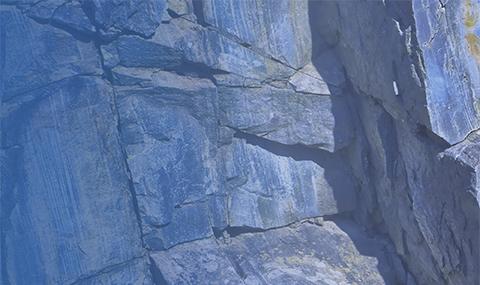The main text of the paper is available here.
The supplementary material contains:
- Supplementary Text (PDF)
-
Movie #1, (avi
 , stream) General phenomenology and creep patches: The movie shows the evolution of the spatial distribution of the slip velocity (top left), normalized friction force (top right) and normalized contact area (bottom left). The driving velocity and critical nucleation length are marked by green dashed lines. A spatiotemporal color map of the same dynamics is shown in the main text in Fig. 1c. The bottom right panel shows a static image of the lateral loading force (per unit out-of-plane width) as a function of time, and the moving vertical line represents time in seconds. The movie shows the successive build-up and extension of creep patches, followed by their loss of stability when they reach the critical nucleation size.
, stream) General phenomenology and creep patches: The movie shows the evolution of the spatial distribution of the slip velocity (top left), normalized friction force (top right) and normalized contact area (bottom left). The driving velocity and critical nucleation length are marked by green dashed lines. A spatiotemporal color map of the same dynamics is shown in the main text in Fig. 1c. The bottom right panel shows a static image of the lateral loading force (per unit out-of-plane width) as a function of time, and the moving vertical line represents time in seconds. The movie shows the successive build-up and extension of creep patches, followed by their loss of stability when they reach the critical nucleation size. -
Movie #2, (avi
 , stream) A temporal close-up on the instability: The movie features in detail the instability of the first creep patch. It shows the normalized friction force (top left), the normalized contact area (bottom left) and the slip velocity in both linear and logarithmic scales (middle top and bottom, respectively). The two right figures are spatiotemporal color maps of the normalized friction force with extremely different temporal time scales, and the moving vertical line represents time (in seconds in the top right panel and in microseconds in the bottom right panel). Due to the enormous variation in time scales, in order to properly observe both the growth of the instability and its outcome, the frame rate is reduced by a factor of ~106 a few tens of microseconds prior to tc (as defined in the main text), and raised back to its original value when the outcome of instability decays.
, stream) A temporal close-up on the instability: The movie features in detail the instability of the first creep patch. It shows the normalized friction force (top left), the normalized contact area (bottom left) and the slip velocity in both linear and logarithmic scales (middle top and bottom, respectively). The two right figures are spatiotemporal color maps of the normalized friction force with extremely different temporal time scales, and the moving vertical line represents time (in seconds in the top right panel and in microseconds in the bottom right panel). Due to the enormous variation in time scales, in order to properly observe both the growth of the instability and its outcome, the frame rate is reduced by a factor of ~106 a few tens of microseconds prior to tc (as defined in the main text), and raised back to its original value when the outcome of instability decays. -
Movie #3, (avi
 , stream) Comparison with steady-state fronts: The movie features the spatial distribution of the various fields during the first instability (solid purple lines) together with a steady state propagating front which propagates at the same velocity and penetrates a region with the same contact area as in the time-dependent simulation (dashed blue line). The panels show the normalized friction force (top), slip velocity (middle) and normalized contact area (bottom). A snapshot of this favorable comparison is shown in Fig. 3b-d of the main text.
, stream) Comparison with steady-state fronts: The movie features the spatial distribution of the various fields during the first instability (solid purple lines) together with a steady state propagating front which propagates at the same velocity and penetrates a region with the same contact area as in the time-dependent simulation (dashed blue line). The panels show the normalized friction force (top), slip velocity (middle) and normalized contact area (bottom). A snapshot of this favorable comparison is shown in Fig. 3b-d of the main text.


